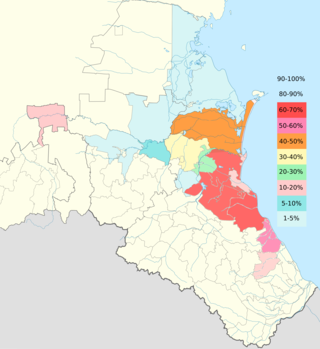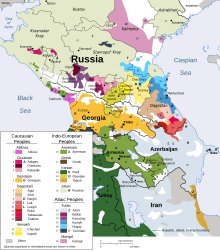
Back اللغة القوموقية Arabic لغه كوموكيه ARZ Idioma cumucu AST ЛъарагӀ мацӀ AV Qumuq dili Azerbaijani قوموق دیلی AZB Ҡумыҡ теле Bashkir Kumīku kalba BAT-SMG Кумыцкая мова BE-X-OLD কুমুক ভাষা Bengali/Bangla
This article should specify the language of its non-English content, using {{lang}}, {{transliteration}} for transliterated languages, and {{IPA}} for phonetic transcriptions, with an appropriate ISO 639 code. Wikipedia's multilingual support templates may also be used - notably kum for Kumyk. (January 2025) |
| Kumyk | |
|---|---|
| къумукъ тил qumuq til قوموق تیل | |
 | |
| Native to | North Caucasus |
| Region | Dagestan, Chechnya, North Ossetia |
| Ethnicity | Kumyks |
Native speakers | 520,000 (2020) |
Turkic
| |
| Cyrillic, Latin, Arabic | |
| Official status | |
Official language in | |
| Language codes | |
| ISO 639-2 | kum |
| ISO 639-3 | kum |
| Glottolog | kumy1244 |
 Share of the Kumyk population in areas of traditional residence in the Caucasus according to the 2010 census | |
 Kumyk is classified as Vulnerable by the UNESCO Atlas of the World's Languages in Danger[1] | |

| External videos | |
|---|---|
A series of videos about the similarities of languages | |
Kumyk (къумукъ тил,[2] qumuq til,[3] قوموق تیل[4][5]) is a Turkic language spoken by about 520,000 people, mainly by the Kumyks, in the Dagestan, North Ossetia and Chechen republics of the Russian Federation.[6] Until the 20th century Kumyk was the lingua franca of the Northern Caucasus.
- ^ "Kumyk in Russian Federation". UNESCO WAL. Retrieved 23 July 2024.
- ^ L. S. Levitskaya, "Kumyk language", in Languages of the world. Turkic languages (1997). (in Russian)
- ^ Book review Retrieved 1 March 2023
- ^ Ногайские и Кумыкский тексты, 1883, М.-Э. Османов, СпБ
- ^ Татарская грамматика кавказского наречия / Сост. Т. Макаровым. - Тифлис : тип. Канцелярии наместника кавк., 1848
- ^ "Kumyksky yazyk | Malye yazyki Rossii" Кумыкский язык | Малые языки России [Kumyk language | Minor languages of Russia]. minlang.iling-ran.ru (in Russian). Retrieved 2023-05-11.
